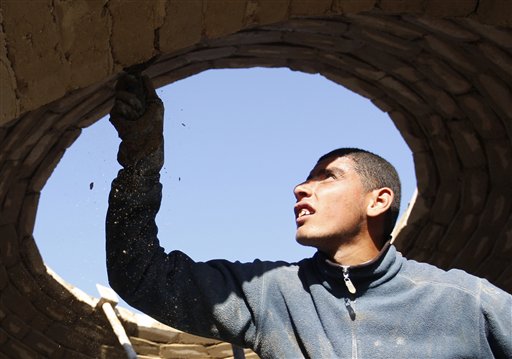 When the UN officials gave Majid Asamna the keys to his new mud-brick home they told him it was just a temporary replacement for the house the Israelis demolished nearly a year ago.
When the UN officials gave Majid Asamna the keys to his new mud-brick home they told him it was just a temporary replacement for the house the Israelis demolished nearly a year ago.But like many Gazans left homeless by the devastating Israeli offensive launched on the Hamas-ruled territory, he is not so sure.
"There will never be reconstruction," he said, as he sipped coffee in front of the dun-coloured structure. "I'm sure these temporary houses will become permanent."
Israel and Egypt have sealed Gaza off to all but limited humanitarian aid since the Islamist Hamas movement seized power in June 2007, and the territory's 1.5 million residents have almost no access to building materials.
Earlier this week, 16 rights groups including Amnesty International and Oxfam accused the international community of having "betrayed" Gaza's civilians by failing to end the blockade.
The groups said in a report that Israel had allowed only 41 truckloads of construction materials into Gaza since the devastating 22-day war ended with reciprocal ceasefires on January 18.


Those parts of the territory most devastated by the war, like the sprawling wasteland of Ezbet Abed Rabbo, where Asamna lives, have changed little since the fighting came to an end.
Until this month, Asamna and many of his neighbours lived in tents and small shelters donated by aid groups and erected on the ruins of their homes.
But then he became the first recipient of a mud-brick home constructed by the UN agency for Palestinian refugees as a stopgap measure to help some of Gaza's homeless survive another winter with no reconstruction in sight.
"This is not an alternative to reconstruction," says Adnan Abu Hasna, a spokesman for the UN Relief and Works Agency (UNRWA), adding that Asamna's home is a "model" for scores of mud-brick homes the agency plans to build.
The first phase of the project calls for the construction of 120 homes at a cost of 12,000 to 15,000 dollars (8,000 to 10,000 euros) each with funding from Kuwait and the Red Crescent Society of the United Arab Emirates.
The agency is training workers to make the mud bricks at its headquarters and hopes to provide dozens of jobs in the territory where more than 80 percent of the population relies on foreign aid.
Some 6,400 homes were destroyed or severely damaged in the conflict, according to UN figures, with most of their owners today confined to tents or forced to crowd in with relatives living elsewhere in Gaza.
Asamna's home was destroyed after some 60 members of his extended family had fled their own homes and taken up residence there. Israeli troops ordered them out before they razed it with bulldozers.
Now he resides in a 70 square metre (750 square foot) mud-brick house with two bedrooms, a kitchen, a bathroom and a small room for receiving guests.
A few metres (yards) away, the dingy tent and small mobile shelter where he has been living with his wife for most of the last year are still standing.
"It's a reminder of our tragedy," he says. "Every time I look at the tent I realise how good the mud house is."
A few Gazans had already erected mud-brick homes on their own earlier this year, and the Hamas-run government has used mud bricks to rebuild one of the many police stations bombed in the opening days of the war.
Umm Jamal, 49, a neighbour of Asamna who also lost her house during the war, hopes to get her mud-brick shelter before the winter rains come to the coastal territory.
"A year is long enough," she said. "We thank UNRWA for this aid, which will make the world pay attention to our disastrous conditions."
Abu Hassan, a 69-year-old refugee from the 1948 war whose home was destroyed in January, remembers living in a similar structure when he was growing up in what is now the Israeli town of Ashkelon.
"I would feel lucky to have a mud-brick house," he says. "I was born in one and the I'll never forget how nice it was... They are warm in the winter and cool in the summer."
Others are less optimistic. Only Gazans who are registered as refugees with the United Nations as a result of the 1948 war that accompanied the creation of Israel are eligible for the mud-brick homes.
The Samuni family, which lost 29 members during the war and had their homes and farms flattened, are not eligible for aid because they are not refugees, Mohammed al-Samuni, 35, says bitterly.
"The (Israeli) occupation never asked us whether we were refugees or natives when they destroyed our homes."


0 comments: